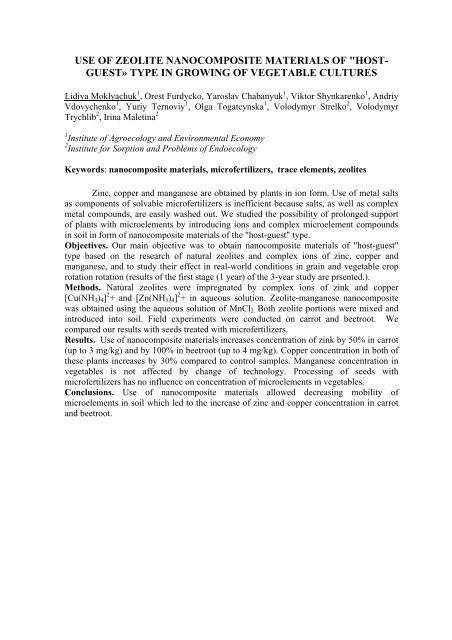Book with abstracts from the COST Action 0905 meeting in ... - UMB
Book with abstracts from the COST Action 0905 meeting in ... - UMB
Book with abstracts from the COST Action 0905 meeting in ... - UMB
You also want an ePaper? Increase the reach of your titles
YUMPU automatically turns print PDFs into web optimized ePapers that Google loves.
USE OF ZEOLITE NANOCOMPOSITE MATERIALS OF "HOST-<br />
GUEST» TYPE IN GROWING OF VEGETABLE CULTURES<br />
Lidiya Moklyachuk 1 , Orest Furdycko, Yaroslav Chabanyuk 1 , Viktor Shynkarenko 1 , Andriy<br />
Vdovychenko 1 , Yuriy Ternoviy 1 , Olga Togatcynska 1 , Volodymyr Strelko 2 , Volodymyr<br />
Trychlib 2 , Ir<strong>in</strong>a Malet<strong>in</strong>a 2<br />
1 Institute of Agroecology and Environmental Economy<br />
2 Institute for Sorption and Problems of Endoecology<br />
Keywords: nanocomposite materials, microfertilizers, trace elements, zeolites<br />
Z<strong>in</strong>c, copper and manganese are obta<strong>in</strong>ed by plants <strong>in</strong> ion form. Use of metal salts<br />
as components of solvable microfertilizers is <strong>in</strong>efficient because salts, as well as complex<br />
metal compounds, are easily washed out. We studied <strong>the</strong> possibility of prolonged support<br />
of plants <strong>with</strong> microelements by <strong>in</strong>troduc<strong>in</strong>g ions and complex microelement compounds<br />
<strong>in</strong> soil <strong>in</strong> form of nanocomposite materials of <strong>the</strong> "host-guest" type.<br />
Objectives. Our ma<strong>in</strong> objective was to obta<strong>in</strong> nanocomposite materials of "host-guest"<br />
type based on <strong>the</strong> research of natural zeolites and complex ions of z<strong>in</strong>c, copper and<br />
manganese, and to study <strong>the</strong>ir effect <strong>in</strong> real-world conditions <strong>in</strong> gra<strong>in</strong> and vegetable crop<br />
rotation rotation (results of <strong>the</strong> first stage (1 year) of <strong>the</strong> 3-year study are prsented.).<br />
Methods. Natural zeolites were impregnated by complex ions of z<strong>in</strong>k and copper<br />
[Cu(NH 3 ) 4 ] 2 + and [Zn(NH 3 ) 4 ] 2 + <strong>in</strong> aqueous solution. Zeolite-manganese nanocomposite<br />
was obta<strong>in</strong>ed us<strong>in</strong>g <strong>the</strong> aqueous solution of MnCl 2. Both zeolite portions were mixed and<br />
<strong>in</strong>troduced <strong>in</strong>to soil. Field experiments were conducted on carrot and beetroot. We<br />
compared our results <strong>with</strong> seeds treated <strong>with</strong> microfertilizers.<br />
Results. Use of nanocomposite materials <strong>in</strong>creases concentration of z<strong>in</strong>k by 50% <strong>in</strong> carrot<br />
(up to 3 mg/kg) and by 100% <strong>in</strong> beetroot (up to 4 mg/kg). Copper concentration <strong>in</strong> both of<br />
<strong>the</strong>se plants <strong>in</strong>creases by 30% compared to control samples. Manganese concentration <strong>in</strong><br />
vegetables is not affected by change of technology. Process<strong>in</strong>g of seeds <strong>with</strong><br />
microfertilizers has no <strong>in</strong>fluence on concentration of microelements <strong>in</strong> vegetables.<br />
Conclusions. Use of nanocomposite materials allowed decreas<strong>in</strong>g mobility of<br />
microelements <strong>in</strong> soil which led to <strong>the</strong> <strong>in</strong>crease of z<strong>in</strong>c and copper concentration <strong>in</strong> carrot<br />
and beetroot.
















